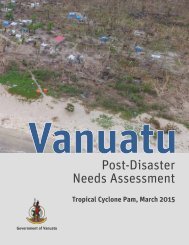Fiji
yqgk302EGjo
yqgk302EGjo
Create successful ePaper yourself
Turn your PDF publications into a flip-book with our unique Google optimized e-Paper software.
FIJI Post-Disaster Needs Assessment<br />
Western<br />
F$29.9<br />
Northern<br />
F$32.9<br />
Central<br />
F$14.4<br />
Eastern<br />
F$49.9<br />
Western<br />
Northern<br />
Eastern<br />
Central<br />
Figure 25: Damage to the Transport Sector by Division (F$ million)<br />
Source: Estimations by Assessment Team<br />
Land Transport: Damaged land transport assets include: roads; bridge approaches, which undermine the structural<br />
integrity of bridges; bridges and crossings; seawalls; and associated structures, such as bus shelters, signs, traffic signals<br />
and streetlights. A large proportion of this damage is due to seawall erosion caused by the cyclone in affected areas in<br />
the Eastern and Northern Divisions, particularly on Koro, Ovalau and Taveuni Islands. In addition, accumulation of debris<br />
caused widespread damage and washouts to bridges, crossing structures and their approaches, with the majority of these<br />
waterway damage sustained on Viti Levu in both the Central and Western Divisions, and in Taveuni in the Northern Division.<br />
The overall extent of the damage to roads may not be fully evident for some time, as water may have penetrated the surface<br />
and affected the base and sub-base courses, which could eventually cause some roadway sections to subside.<br />
Maritime Transport: Maritime transport assets damaged by TC Winston include rural jetties, navigation aids, channel<br />
markers, lighthouses and international ports, including the associated port terminal buildings. Rural jetties accounted for<br />
the largest proportion of damage in the subsector, particularly the Lomaloma jetty at Vanua Balavu in the Eastern Division,<br />
which became inaccessible due to severe causeway damage near the jetty head and will require significant rehabilitation.<br />
Damage to rural jetties was a result of king tides and heavy swells that mostly eroded the causeway structures.<br />
Aviation: Damaged aviation subsector assets include runways, terminal buildings and security fences at the Nadi, Taveuni<br />
and Savusavu airports. Debris on the runways was cleared following the cyclone.<br />
Figure 26: Damage Sites in the Central, Western and<br />
Eastern Divisions<br />
Source: Assessment Team.<br />
Figure 27: Damage Sites in the Northern and Eastern<br />
Divisions<br />
Source: Assessment Team.<br />
Losses to the Transport Sector (F$2 million)<br />
Total losses sustained by the transport sector are estimated at F$2.4 million, with the majority of recorded losses incurred<br />
in the land and maritime subsectors.<br />
Land Transport: Total losses sustained to land transport are estimated at F$2.4 million. Losses relate mainly to higher<br />
vehicle operating costs and passenger travel times along key national corridors, which were disconnected due to the<br />
presence of debris on roads, or bridge washouts and approach scouring. In particular, trip durations increased significantly<br />
between Suva-Nadi, Nadi-Lautoka, Lautoka-Rakiraki, Rakiraki-Suva and Labasa-Savusavu, and even doubled along<br />
selected sections of roads. The Nadi-Suva and Labasa-Savusavu corridors required up to a week from the disaster to<br />
restore normal connectivity, while the remaining sections took up to three weeks.<br />
80 Tropical Cyclone Winston, February 20, 2016



